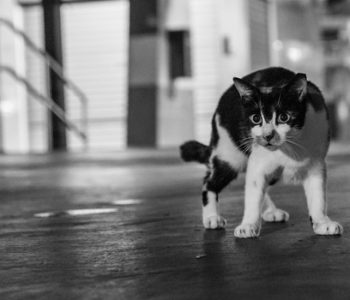Modeling Free-Roaming Cat Management Strategies
Free-roaming cat populations face predation, starvation, extreme weather, and disease. They also cause problems for the communities they inhabit, particularly by harming local wildlife. Exacerbating these challenges, free-roaming cats reproduce very quickly: the average unsterilized female cat has one to two litters per year, each averaging 3.5 kittens. Many communities have responded by attempting to manage their free-roaming cat populations. Popular strategies include removal, in which cats are captured and either euthanized or adopted, and trap-neuter-release (TNR), in which cats are captured, sterilized, vaccinated, and then released back to their original location.
Communities and advocates have long engaged in a robust debate about the merits of TNR, in which TNR has often been advocated as a more humane way of reducing free-roaming cat populations because it does not require the euthanasia of healthy cats. This study quantitatively compares removal and TNR over the longer term, focusing in particular on the total number of free-roaming cat deaths that result from each strategy.
To do this, the authors adapt a mathematical model that simulates how a population of free-roaming cat populations grows or shrinks over time. Every six months, the model simulates new births, deaths from natural causes, new cats introduced to the population by immigration or abandonment, and the effects of free-roaming cat management strategies. Importantly, the kitten mortality rate — which plays a central role in how the authors compare different management strategies — depends on the total cat population. Larger free-roaming cat populations increase the competition for resources, reducing the likelihood that kittens will survive to adulthood.
The study evaluated the efficacy of removal and TNR in terms of the number of preventable deaths, which includes adult cats who are euthanized and kittens who die before reaching six months of age. (The study did not consider the death of adult cats in the wild preventable.) The authors considered an initial population of 50 cats as the environmental carrying capacity, meaning that the number of cats was expected to stay approximately constant in the absence of any management. Under this baseline of no management, approximately 1000 kittens die over ten years due to environmental stress.
The authors found that even when accounting for deaths caused by euthanasia, removal can actually reduce total deaths over the long run. This was because removing cats from the population reduced the number of kittens born who would not have survived to adulthood. If 25% of cats were removed every six months, the total number of deaths over ten years would be reduced from 1000 to about 600: about 150 adults from euthanasia, and about 450 kittens from environmental stress. If 50% of cats were removed every six months (the approximate rate of campaigns in some protected wildlife areas), the total number of preventable deaths would be further reduced to about 200 over ten years: about 100 from euthanasia, and about 100 from natural causes. If removed cats could be adopted rather than euthanized, the benefit of lowering kitten mortality could be achieved without the deaths caused by euthanasia.
TNR was found to also greatly reduce preventable deaths. Sterilizing 25% of cats every six months decreased total deaths over ten years from 1000 (the no-management scenario) to about 300. If instead 75% of cats were sterilized every six months (the rate achieved by some high-intensity targeted TNR programs), total deaths over ten years would be reduced from 1000 to just 32 — a more than 30-fold reduction. In both cases, the majority of the final population was introduced by immigration and abandonment, echoing previous studies that have suggested that educating pet owners about the harm of abandonment is important for TNR to be successful.
The results of this paper suggest that the negative short-term impacts of removal and TNR produce a large benefit in the long-term by reducing total deaths. This long-term benefit becomes particularly significant when management is performed at higher intensity.
An important consideration when choosing a free-roaming cat management strategy is the damaging effect that cats have on wildlife. The model in this study sheds light on the effectiveness of different management strategies in this regard by modeling the total adult cat population over time. TNR reduces the free-roaming cat population by about one-quarter to one-half, depending on the sterilization rate. Removal, however, can reduce the population much more significantly, in turn reducing the impact on wildlife.
Many factors dictate the best free-roaming cat management strategy: cat welfare, wildlife impacts, and practicality. Studies like this, which provide a clearer understanding of trade-offs and long-term effects, can help advocates select the most effective and humane strategy for free-roaming cat management in their communities.




















